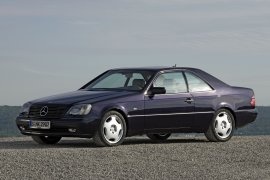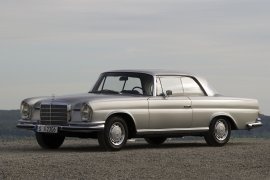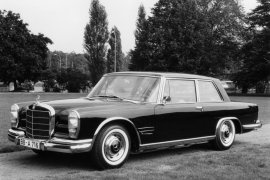
MERCEDES BENZ CL-Klasse and predecessors
Generations Timeline, Specs and Pictures

The facelift version of the Mercedes CL-Class made its world debut in July 2010 at the Goodwood Festival of Speed.
The new CL-Class comes with an improved exterior and interior, but the biggest changes are found under the hood. The exterior gets a new grille, bi-xenon headlights with LED technology, LED fog lamps, revised fenders and hood, and new exhaust pipes. On the interior the biggest change is the addition of a new wood trim. The new CL-Class will also be offered with all the latest technologies including: Active Blind Spot Assist, Attention Assist, Active Lane Keeping Assist, Night View Assist Plus, and Active Body Control.

The 2006 Mercedes-Benz CL continued the great line of Gran Tourer vehicles from the German premium car-maker.
It was offered only with gasoline engines.
The 2006 CL was a bit longer than its predecessor, but it had a lot more to offer. From the interior room and bigger trunk to the advanced suspension and more powerful engines, everything was changed. It was the result of six years of development.
A long hood, curved greenhouse, and no B-pillars were some of the features of the Mercedes-Benz CL. It kept that from its predecessor and enhanced them in every way. With a better aerodynamic that led to lower wind noise and enhanced look, it was on top of its class. With a side sculptured line across the entire body, and rear flared arches, it inspired both elegance and sportiness.
Inside, the luxury features were carried over from the S-Class inventory. Large, comfortable front seats were installed. To enhance comfort and clean-up the center console between the front passengers, the CL featured a steering-column mounted gearshift for the automatic transmission. To enhance the ride quality, a panoramic glass roof was fitted as standard.
For more comfort, the car featured the Active Body Control system, that controlled the car’s rigidity, or better cornering speed when it was set in the sport mode. For the engine compartment, the CL featured four V8 engines and two V12, with the AMG versions included. All vehicles featured automatic transmission.

Based on the former S-Klasse, the new CL comes with a shorter wheelbase and plenty more tech.
Although styling has been kept almost unchanged, the car was fitted with lots of goodies, such as a new Active Body Control suspension system and Dual Xenon HID head-lamps. As with all of Mercedes-Benz built vehicles, performance meets luxury in a well sound-proofed interior, complete with an excessive attention for details and commands at the driver’s fingertips. The car was released with a very attractive range of engines, including a supercharged (Kompressor) V8 and a twin-turbo V12, both available with the AMG versions.

Not only have the blokes over at Mercedes-Benz practically invented the coupe-class but they have endowed it with outrageous features.
Such is the case with the CL, especially the 600 model, built on an S-Klasse sourced platform. Smaller and leaner, this particular model is powered by a V12 which not only holds you in your seat when throttled but also delivers a painstaking punch to your internal organs. Powerful and refined with a finely crafted interior emphasized by multiple steering wheel, console and door wood-insertions, the CL is a must-have speeding beauty. It even comes with a pneumatic close-door assist mechanism and a low 0.30 drag coefficient.

In its pursuit to offer a coupe version for its flagship model, the S-Class, Mercedes-Benz struggled to find a proper name and, in 1996, it came up with the CL designation.
The 1996 CL was more of a facelift for the SEC model, that was built since 1992. Both the SEC and the CL shared the same modified platform from the W140 S-Class sedan. It was built more like a grand tourer, with four rear seats and comfortable suspension.
The CL didn’t look like a sports car. It was tall, wide, and with a big front fascia. It borrowed some styling principles from the S-Class. On the side, the frameless windows and the rear windows could roll down and, without a B-pillar, the car offered the image of a faux-cabriolet (fake cabriolet).
Inside, it was built as a luxury vehicle, with a big and tall dashboard, a straight center stack and more features carried over from the S-Class. Its instrument cluster featured five round dials with a total of seven gauges for various information. The leather upholstery and the wood grain were standard. As a novelty for those times was the parktronic system, which added parking sensors and digital displays for it.
For the engine bay, the car-maker installed only V8 and V12 gasoline units mated to a standard 5-speed automatic gearbox. For safety systems, the CL was fitted with a traction control system.

The C140 is the result of avantgarde thinking and costly development that is said to have pulled close to $1 billion out of the MB vault.
However, the new S line-up exceeded expectations and became immensely successful. Ownership of such a car is a privilege due to small production volume comprising some 20,000 units compared to number registered by the sedan which was built in nearly half a million units. Engineering breakthroughs led to fitting both the coupe and saloon with modern suspension systems (double wishbone front axle/ multi-link rear) and ESP. Both cars were avaialble with a choice of 12V configured petrol-sucking monstrosity that developed 408 hp.

Mercedes-Benz launched the 380 SEC and 500 SEC at the 1981 Frankfurt Motor Show.
It was the successor of the previous SLS range, and it was based on the same platform with the S-Class W126.
With a high-demand for personal luxury coupes, Mercedes-Benz offered a new generation of S-Class coupe in the form of the SEC models, in 1981. Its success was so big that the car-maker decided to make it until 1992. The SEC was facelifted in 1984.
From the outside, the sleek coupe line was inspired by the four-door sedan version, but it didn’t carry too many body panels from that. The front fascia was similar, but not the same. A different grille design and similar headlights were installed. The raked A-pillars and the long front doors were a stylish mark for the SEC generation. The B-pillar was removed and with all four windows rolled down, it looked like a faux-cabriolet.
Inside, the car offered seating for four. It was the first car to feature a seat belt presenter. When the doors were closed, and the engine started, the presenters extended the shoulder anchor to the front passengers, to ease the reach and grab of seat belts. The standard version featured cloth seats, while in the upper trim level the leather upholstery and the wood grain on the dash, center console, and stack were standard fit.
In the U.S., the SEC was available with the 3.8-liter V8 engine only, due to the CAFE regulations. Some gray imports allowed the introduction of some 500 SEC until the law was changed and the potential customers couldn’t buy them anymore. The standard transmission for the entire range was a 4-speed automatic. In 1985, the 3.8-liter unit was replaced by the larger 4.2-liter and the 5.6-liter V8 was introduced.

Mercedes-Benz introduced the SLC at the 1971 Paris Motor Show as a fixed-roof version for the SL Roadster R107.
While the carmaker already offered a removable hardtop for the SL roadster, the customers demanded a two-door version. Despite having a closed-body construction, it wasn’t stiffer than its roadster brother, but it was a personal luxury coupe that carried over the legacy of the SL300 “Gullwing” model.
Unlike its open-top sibling, it featured a longer wheelbase. At the front, it featured the same front fascia with a black grille that sported the big three-pointed-star badge and a chromed horizontal slat. Its corner-mounted turn-signals were raised on the rear side. Mercedes-Benz designers hid the extended cabin by adding a fixed glass panel behind the rear side windows. By those time standards, it was a fake-cabriolet.
Mercedes-Benz made the SLC longer than the roadster so that it could fit a bench in the rear. Thus, the two-seat roadster was able to host four occupants inside. Yet, there was limited legroom in the back, if any, depending on the driver’s height. The list of standard features was long and included air-conditioning and a stereo.
The SLC received a 3.5-liter V-8 engine at the launch, with a 4.5-liter joining the range in 1973. After the oil crisis from the same year, the carmaker rushed and installed a 2.8-liter, fuel-injected engine. It was an intelligent decision since its fuel efficiency was far better than the carburetor-type 3.5-liter unit. By the late ’70s, the SLC received a 5.0-liter V-8 paired with a standard automatic transmission. It was the first V-8 car to win a World Rally Championship event.

In 1961, Mercedes-Benz showed an open-top version of the 220 SEb sedan coupe.
It was the successor of the 128 convertible, a model that was no longer produced since 1960.
Unlike their predecessors, the W111 and the W112 were planned to be true four-seated vehicles. To get that, the car-maker used the same chassis from the sedan, with the same wheelbase. Unlike the sedan though, it didn’t feature the same tailfins. The success of the car showed by the German car-maker, convinced the management that it will be a successful model. And it was.
The headlights and the radiator grille were the same as for the 220 SEb sedan with gasoline engines. On the sides, the longer doors were similar to the coupe versions but the rear was unlike the other two. While the four-door featured tailfins, the coupe had them lowered and the convertible didn’t feature them.
Inside, the car featured leather and chromed all over the place. The luxurious interior was meant for rich people with high taste and big expectations. The car was fitted as standard with a 4-speed automatic transmission just to enhance the driving experience.
Under the hood, the W111 cabriolet featured a choice of engines with mechanical fuel injection built by Bosch. The rarest version was the 300 SE with a 3.0-liter inline-six engine with only 708 units produced. The top model featured the 3.5-liter V8 unit, which was produced in 1232 units.

Part of the Fintail(Heckflosse) line-up, the coupes were released along the full-size sedan stablemates to increase market coverage.
Large and luxurious, these vehicles were primarily tailored for the North American market, hence the name which came from the rear fintail-like adornments that are said to have been atrophied replicas of those found on the exagerrately finned American cars. However appealing the exterior may have been, the car’s underpinnings were the true attraction with the advanced air-suspension system and crumple-zones that acted like buffers in the event of a crash and collapsed to reduced the risk of car parts entering the cabin.

After the Mercedes-Benz 600 Laundaulet built in one unit for former racing driver Count von Berckheim in 1967, the 600 Coupe was the rarest W100 ever made.
The 600 Coupe was built in only two original units and none of them were sold. They were offered as gifts for the former chief designer Rudolf Uhlenhaut and the other for Fritz Nallinger, former head of research and development department of the Mercedes. These were the only two vehicles built in 1965. These cars had a shorter wheelbase 22 cm (8.6“) than the SWB sedan. There was a custom-built third vehicle, which was transformed from a short-wheelbase W100 into a coupe.
The design of the car was identical to the four-door version up until the A-pillars. A longer front door was needed to ease the access to the rear seats. The rear side windows were custom made but the rear window was the same as for the rest of the W100.
Inside, the access was via the front doors and reclining front seats. Since both vehicles were built for special order, they were fitted with all the amenities that were available. The air-conditioning unit and the wood trims for the interior were part of the features.
Under the hood, the engineers installed the same 6.3-liter M100 engine from the rest of the W100 range. Other mechanical adjustments were needed, but the final result was considered as the first personal luxury coupe built by Mercedes-Benz after WWII.

Asides from having assumed a new form due to the innovative unibody construction, Pontons were also upgraded thanks to a large number of engine and suspension tweaks.
The previously popular independent suspension, comprising front coil springs and rear de Dion axle, introduced on the second Grosser series, was replaced with a contemporary front double wishbone with coil springs mated to a stabilizer bar setup and a rear swing axle with radius arms and coil springs ensemble. Among other technical aspects, steering was controlled through a recirculating ball system while braking was made through a power assist circuit connected to all-wheel drum brakes.

The 1956 Mercedes-Benz 220 S and 220 SE Cabriolet are rare gems in automotive history.
The German car-manufacturer built only 5731 of these, from which 1942 were the fuel-injected SE.
Just two months after the last 220 A Convertible roll-out from the factory in 1955 and a 220 Convertible based on Type 220 A sedan was shown at the Frankfurt Motor Show. It was built on a shortened chassis by 120 mm (4.7”) when compared with the 220 S. But the vehicle shown was just a show and it didn’t go into production.
The model series that went into production in 1956 but was based instead on the 220 S, the successor of the 220 A. The turn-signal placed on top of the front fenders, the integrated taillights in the rear quarter-panels, the wider hood, and the tall grille were just a few details that showed the design change in the Mercedes-Benz philosophy.
Under the hood, there was an inline-six engine with two downdraught carburetors that produced 106 hp in 1957. A year later, a single point injection (the injector was in the manifold) was available and increased the output to 115 hp. The engine featured a chain-driven overhead camshaft with two valves per cylinder.
In 1959, three completely redesigned 6-cylinder engines and a new “fintail” body were presented along with the new sedan versions. These engines were also installed in the 220 Cabriolet. The last carburetor engine was installed in the convertible in October 1959. The new injection system, along with higher camshafts and straight pipes increased the output to 120 hp.

Reminiscent of the W186 styling, the coupe made its arrival as a stylish car that was quick to become one of the world’s top selling in its class.
After the minor engine tweaks made in 1952, the car went through a mid-life facelift in 1955 when it saw the introduction of several augments such as a rear “low-pivot” independent suspension and a new fuel injector in the Sc model, boosting the 6-straight engine’s power output to 173 hp. Compared to the pre-facelift production numbers, cars until 1958 were scarcely released, being some of MB’s rarest.

The 300 range was updated in 1952 with the introduction of a new platform that widely contributed to the vehicle’s popularity.
Unveiled at the Paris Auto Show in October 1951, the car sported a coupe body-type with a 2+2 seating configuration and styling similar to the previously released W186 models. Dubbed as the Cabriolet A, the car shared most of its underpinnings with the older version although the newly introduced triple Solex carburetors and nearly 8.1 compression ratio boosted the engine’s power output to 148 hp. The car was built in very few units until 1955 when it was revamped once more.























































